| dc.contributor.author | Herring, Keith T. | |
| dc.contributor.author | Holloway, Jack W. | |
| dc.contributor.author | Staelin, David H. | |
| dc.contributor.author | Bliss, Daniel W., Jr. | |
| dc.date.accessioned | 2012-09-20T19:48:00Z | |
| dc.date.available | 2012-09-20T19:48:00Z | |
| dc.date.issued | 2009-11 | |
| dc.date.submitted | 2009-07 | |
| dc.identifier.issn | 0018-926X | |
| dc.identifier.issn | 1558-2221 | |
| dc.identifier.uri | http://hdl.handle.net/1721.1/73088 | |
| dc.description.abstract | Wireless channel data was collected in Cambridge, Massachusetts for diverse propagation environments over distances ranging from tens of meters to several kilometers using mobile 2.4-GHz transmitters and receivers. The 20-MHz bandwidth signals from eight individually movable van-top antennas were Nyquist sampled simultaneously with 12-bit accuracy. Although path-loss variance for any given link length within single residential/urban neighborhoods was large, single streets typically exhibited path-loss, L(dB)=-10 log10 (Pr/Pt) ?? 10?? log10 r + C, where P is the received or transmitted power, r the link-length, ?? the street-dependent path-loss coefficient, and C the loss incurred at street intersections. Measurements yielded ?? ?? 1.5 + 3.2?? ?? 0.27 for 2 < ?? < 5; ?? is the fraction of the street length having a building gap on either side. Experiments over links as short as 100 meters indicate a 10-dB advantage in estimating path loss for this model compared to optimal linear estimators based on link length alone. Measured air-to-ground links were well modeled by ?? = 2 for the elevated LOS path, and by stochastic log-normal attenuation for the ground-level scattering environment. These models permit path-loss predictions based on readily accessible environmental parameters, and lead to efficient nodal placement strategies for full urban coverage. | en_US |
| dc.description.sponsorship | National Science Foundation (U.S.) (Grant ANI-0333902) | en_US |
| dc.language.iso | en_US | |
| dc.publisher | Institute of Electrical and Electronics Engineers (IEEE) | en_US |
| dc.relation.isversionof | http://dx.doi.org/10.1109/tap.2009.2036278 | en_US |
| dc.rights | Article is made available in accordance with the publisher's policy and may be subject to US copyright law. Please refer to the publisher's site for terms of use. | en_US |
| dc.source | IEEE | en_US |
| dc.title | Path-Loss Characteristics of Urban Wireless Channels | en_US |
| dc.type | Article | en_US |
| dc.identifier.citation | Herring, K.T. et al. “Path-Loss Characteristics of Urban Wireless Channels.” IEEE Transactions on Antennas and Propagation 58.1 (2010): 171–177. © Copyright 2009 IEEE | en_US |
| dc.contributor.department | Lincoln Laboratory | en_US |
| dc.contributor.department | Massachusetts Institute of Technology. Research Laboratory of Electronics | en_US |
| dc.contributor.mitauthor | Herring, Keith T. | |
| dc.contributor.mitauthor | Holloway, Jack W. | |
| dc.contributor.mitauthor | Staelin, David H. | |
| dc.contributor.mitauthor | Bliss, Daniel W., Jr. | |
| dc.relation.journal | IEEE Transactions on Antennas and Propagation | en_US |
| dc.eprint.version | Final published version | en_US |
| dc.type.uri | http://purl.org/eprint/type/JournalArticle | en_US |
| eprint.status | http://purl.org/eprint/status/PeerReviewed | en_US |
| dspace.orderedauthors | Herring, K.T.; Holloway, J.W.; Staelin, D.H.; Bliss, D.W. | en |
| dc.identifier.orcid | https://orcid.org/0000-0003-4565-5388 | |
| mit.license | PUBLISHER_POLICY | en_US |
| mit.metadata.status | Complete | |
